The Impacts of Technology on Accounting Practices: UK Food Industry
VerifiedAdded on 2023/01/05
|30
|10327
|68
Report
AI Summary
This report delves into the impact of technology on accounting practices, specifically focusing on the UK food industry. It explores the concept of technology in accounting, detailing various methods of implementation such as cloud computing and accounting software. The report further analyzes the challenges encountered during technology adoption, including potential negative impacts on accounting jobs and the need for continuous technological knowledge. Through a literature review and structured analysis, the report examines the significance of technology in improving efficiency and accuracy in financial operations. It also discusses the rationale behind the research, emphasizing the increasing integration of technology in business and the potential benefits for UK retail sectors. Finally, the report offers recommendations to overcome the challenges and enhance the positive outcomes of technology implementation in accounting, concluding with the key findings and contributions of the study.
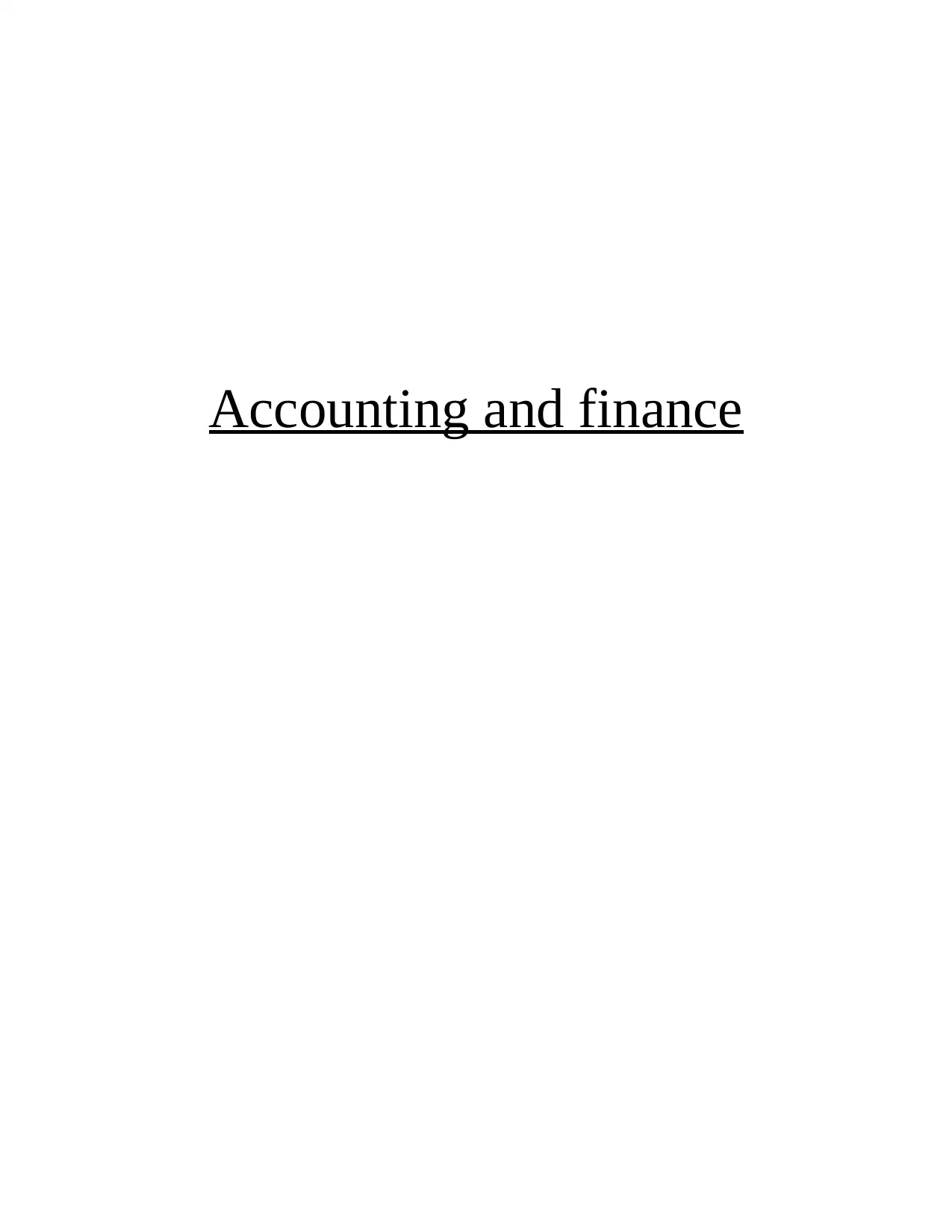
Accounting and finance
Paraphrase This Document
Need a fresh take? Get an instant paraphrase of this document with our AI Paraphraser
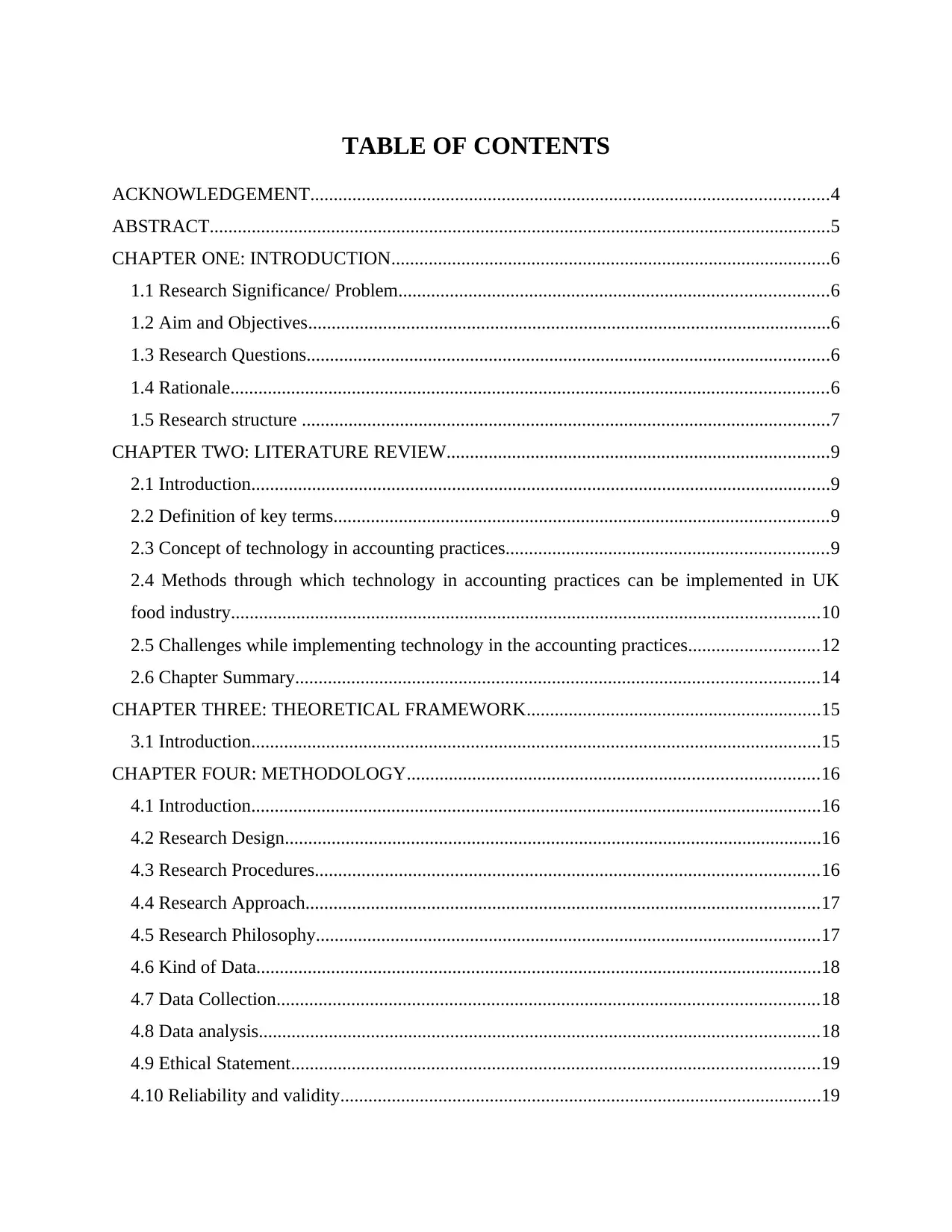
TABLE OF CONTENTS
ACKNOWLEDGEMENT...............................................................................................................4
ABSTRACT.....................................................................................................................................5
CHAPTER ONE: INTRODUCTION..............................................................................................6
1.1 Research Significance/ Problem............................................................................................6
1.2 Aim and Objectives................................................................................................................6
1.3 Research Questions................................................................................................................6
1.4 Rationale................................................................................................................................6
1.5 Research structure .................................................................................................................7
CHAPTER TWO: LITERATURE REVIEW..................................................................................9
2.1 Introduction............................................................................................................................9
2.2 Definition of key terms..........................................................................................................9
2.3 Concept of technology in accounting practices.....................................................................9
2.4 Methods through which technology in accounting practices can be implemented in UK
food industry..............................................................................................................................10
2.5 Challenges while implementing technology in the accounting practices............................12
2.6 Chapter Summary................................................................................................................14
CHAPTER THREE: THEORETICAL FRAMEWORK...............................................................15
3.1 Introduction..........................................................................................................................15
CHAPTER FOUR: METHODOLOGY........................................................................................16
4.1 Introduction..........................................................................................................................16
4.2 Research Design...................................................................................................................16
4.3 Research Procedures............................................................................................................16
4.4 Research Approach..............................................................................................................17
4.5 Research Philosophy............................................................................................................17
4.6 Kind of Data.........................................................................................................................18
4.7 Data Collection....................................................................................................................18
4.8 Data analysis........................................................................................................................18
4.9 Ethical Statement.................................................................................................................19
4.10 Reliability and validity.......................................................................................................19
ACKNOWLEDGEMENT...............................................................................................................4
ABSTRACT.....................................................................................................................................5
CHAPTER ONE: INTRODUCTION..............................................................................................6
1.1 Research Significance/ Problem............................................................................................6
1.2 Aim and Objectives................................................................................................................6
1.3 Research Questions................................................................................................................6
1.4 Rationale................................................................................................................................6
1.5 Research structure .................................................................................................................7
CHAPTER TWO: LITERATURE REVIEW..................................................................................9
2.1 Introduction............................................................................................................................9
2.2 Definition of key terms..........................................................................................................9
2.3 Concept of technology in accounting practices.....................................................................9
2.4 Methods through which technology in accounting practices can be implemented in UK
food industry..............................................................................................................................10
2.5 Challenges while implementing technology in the accounting practices............................12
2.6 Chapter Summary................................................................................................................14
CHAPTER THREE: THEORETICAL FRAMEWORK...............................................................15
3.1 Introduction..........................................................................................................................15
CHAPTER FOUR: METHODOLOGY........................................................................................16
4.1 Introduction..........................................................................................................................16
4.2 Research Design...................................................................................................................16
4.3 Research Procedures............................................................................................................16
4.4 Research Approach..............................................................................................................17
4.5 Research Philosophy............................................................................................................17
4.6 Kind of Data.........................................................................................................................18
4.7 Data Collection....................................................................................................................18
4.8 Data analysis........................................................................................................................18
4.9 Ethical Statement.................................................................................................................19
4.10 Reliability and validity.......................................................................................................19
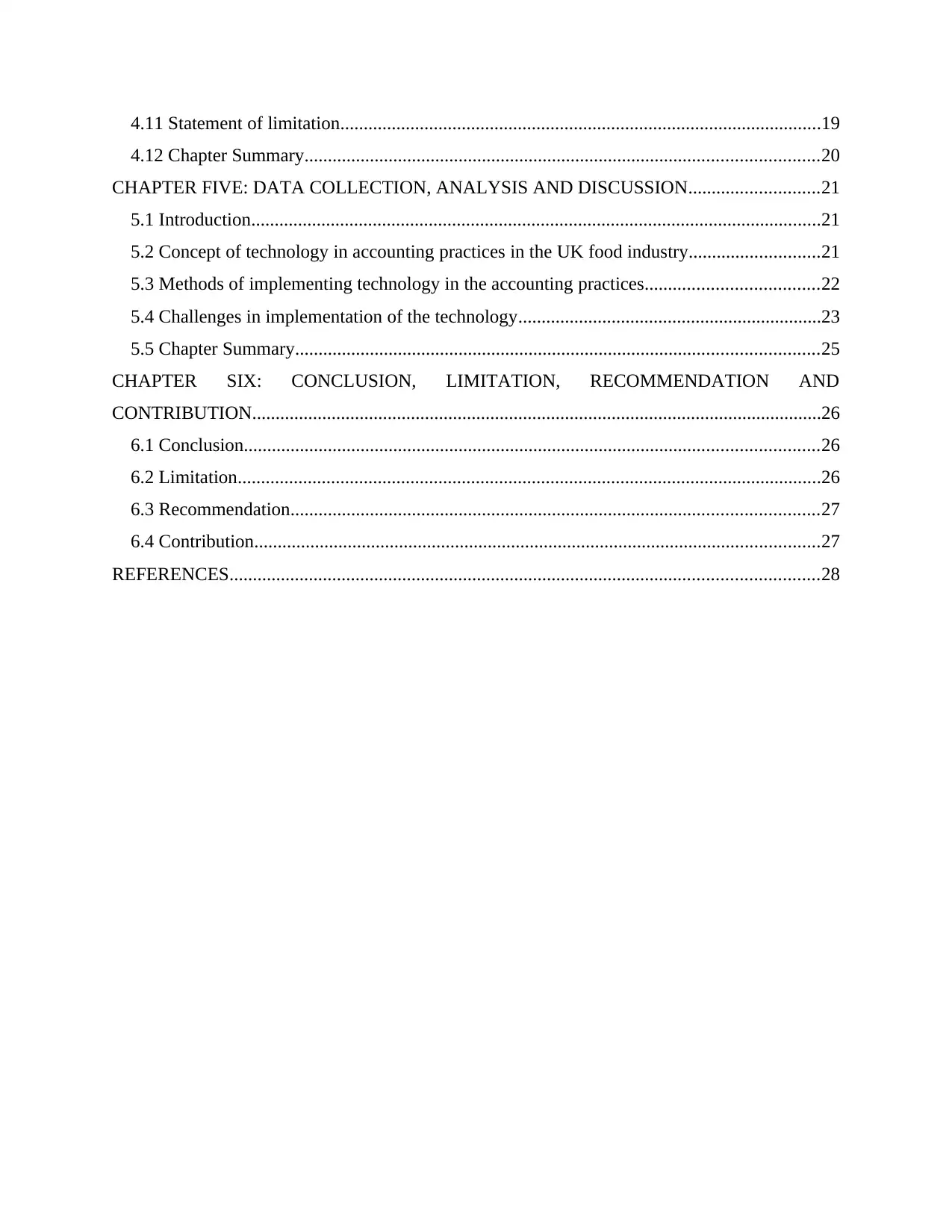
4.11 Statement of limitation.......................................................................................................19
4.12 Chapter Summary..............................................................................................................20
CHAPTER FIVE: DATA COLLECTION, ANALYSIS AND DISCUSSION............................21
5.1 Introduction..........................................................................................................................21
5.2 Concept of technology in accounting practices in the UK food industry............................21
5.3 Methods of implementing technology in the accounting practices.....................................22
5.4 Challenges in implementation of the technology.................................................................23
5.5 Chapter Summary................................................................................................................25
CHAPTER SIX: CONCLUSION, LIMITATION, RECOMMENDATION AND
CONTRIBUTION..........................................................................................................................26
6.1 Conclusion...........................................................................................................................26
6.2 Limitation.............................................................................................................................26
6.3 Recommendation.................................................................................................................27
6.4 Contribution.........................................................................................................................27
REFERENCES..............................................................................................................................28
4.12 Chapter Summary..............................................................................................................20
CHAPTER FIVE: DATA COLLECTION, ANALYSIS AND DISCUSSION............................21
5.1 Introduction..........................................................................................................................21
5.2 Concept of technology in accounting practices in the UK food industry............................21
5.3 Methods of implementing technology in the accounting practices.....................................22
5.4 Challenges in implementation of the technology.................................................................23
5.5 Chapter Summary................................................................................................................25
CHAPTER SIX: CONCLUSION, LIMITATION, RECOMMENDATION AND
CONTRIBUTION..........................................................................................................................26
6.1 Conclusion...........................................................................................................................26
6.2 Limitation.............................................................................................................................26
6.3 Recommendation.................................................................................................................27
6.4 Contribution.........................................................................................................................27
REFERENCES..............................................................................................................................28
⊘ This is a preview!⊘
Do you want full access?
Subscribe today to unlock all pages.

Trusted by 1+ million students worldwide
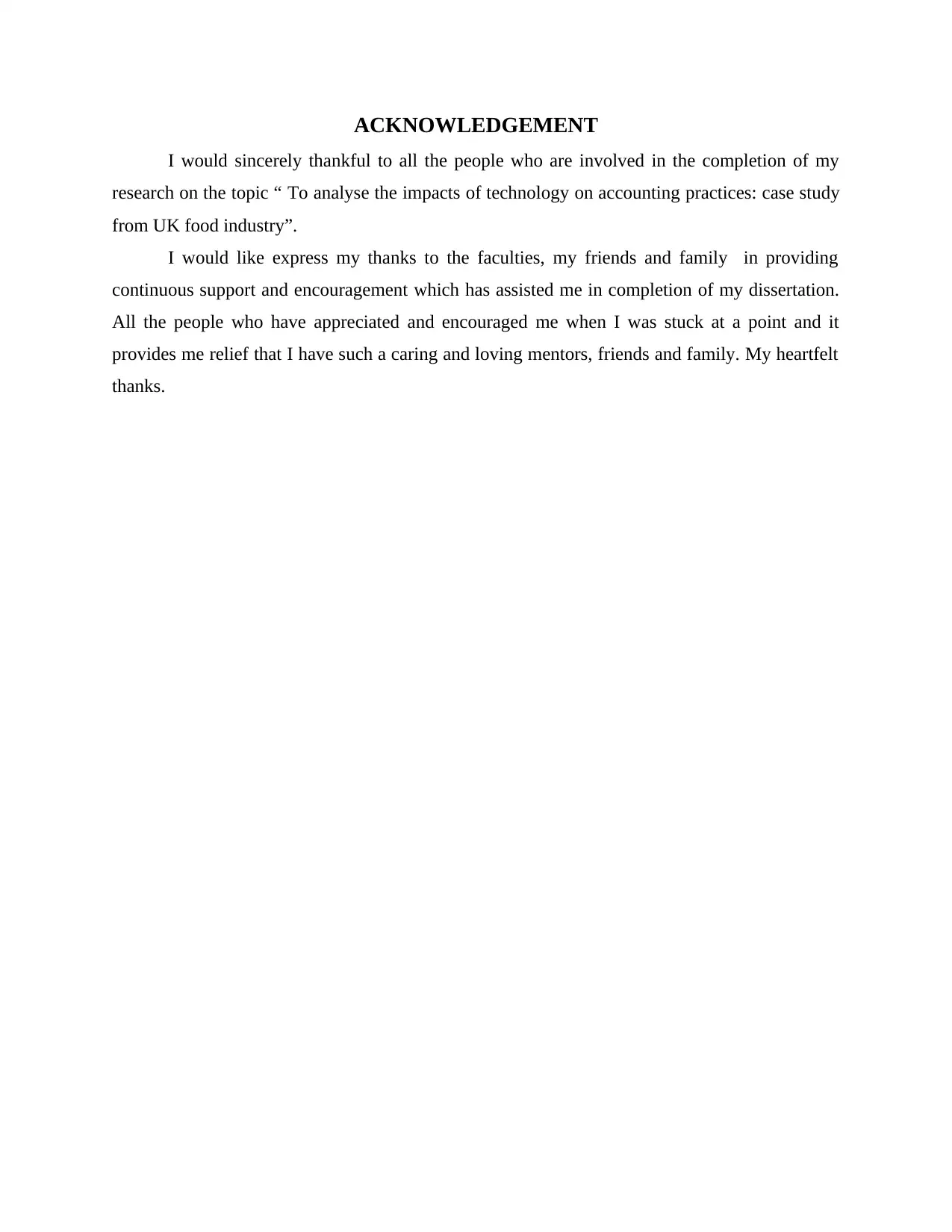
ACKNOWLEDGEMENT
I would sincerely thankful to all the people who are involved in the completion of my
research on the topic “ To analyse the impacts of technology on accounting practices: case study
from UK food industry”.
I would like express my thanks to the faculties, my friends and family in providing
continuous support and encouragement which has assisted me in completion of my dissertation.
All the people who have appreciated and encouraged me when I was stuck at a point and it
provides me relief that I have such a caring and loving mentors, friends and family. My heartfelt
thanks.
I would sincerely thankful to all the people who are involved in the completion of my
research on the topic “ To analyse the impacts of technology on accounting practices: case study
from UK food industry”.
I would like express my thanks to the faculties, my friends and family in providing
continuous support and encouragement which has assisted me in completion of my dissertation.
All the people who have appreciated and encouraged me when I was stuck at a point and it
provides me relief that I have such a caring and loving mentors, friends and family. My heartfelt
thanks.
Paraphrase This Document
Need a fresh take? Get an instant paraphrase of this document with our AI Paraphraser
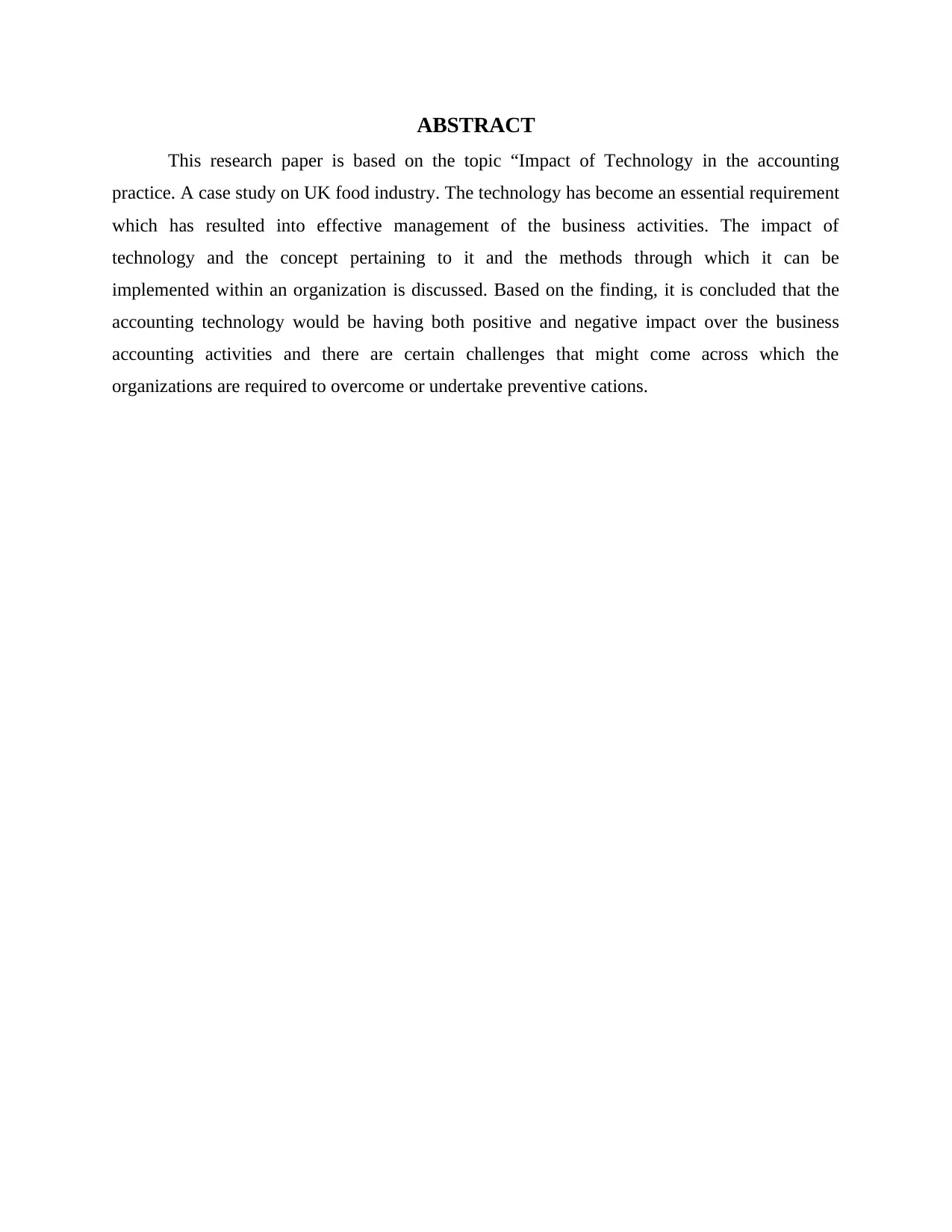
ABSTRACT
This research paper is based on the topic “Impact of Technology in the accounting
practice. A case study on UK food industry. The technology has become an essential requirement
which has resulted into effective management of the business activities. The impact of
technology and the concept pertaining to it and the methods through which it can be
implemented within an organization is discussed. Based on the finding, it is concluded that the
accounting technology would be having both positive and negative impact over the business
accounting activities and there are certain challenges that might come across which the
organizations are required to overcome or undertake preventive cations.
This research paper is based on the topic “Impact of Technology in the accounting
practice. A case study on UK food industry. The technology has become an essential requirement
which has resulted into effective management of the business activities. The impact of
technology and the concept pertaining to it and the methods through which it can be
implemented within an organization is discussed. Based on the finding, it is concluded that the
accounting technology would be having both positive and negative impact over the business
accounting activities and there are certain challenges that might come across which the
organizations are required to overcome or undertake preventive cations.
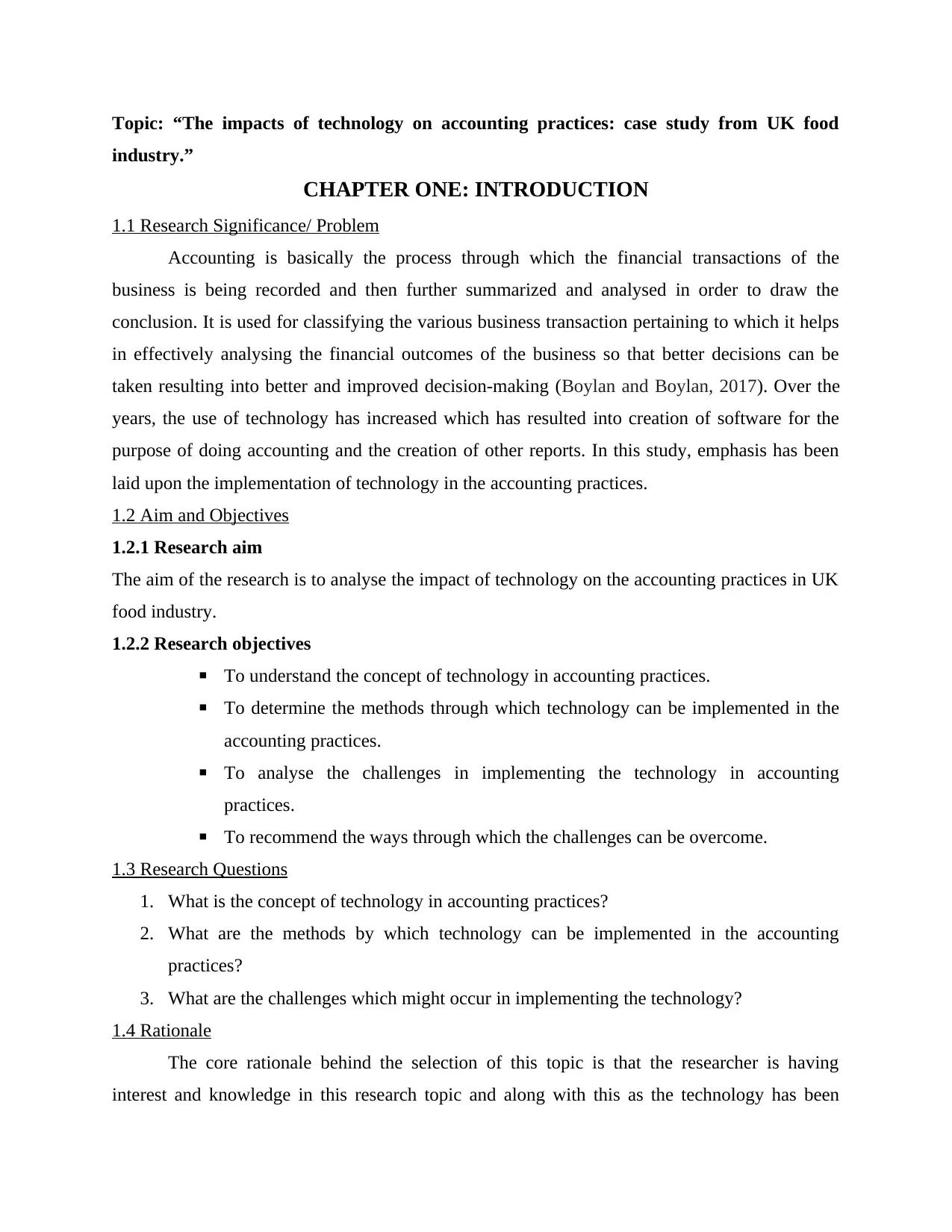
Topic: “The impacts of technology on accounting practices: case study from UK food
industry.”
CHAPTER ONE: INTRODUCTION
1.1 Research Significance/ Problem
Accounting is basically the process through which the financial transactions of the
business is being recorded and then further summarized and analysed in order to draw the
conclusion. It is used for classifying the various business transaction pertaining to which it helps
in effectively analysing the financial outcomes of the business so that better decisions can be
taken resulting into better and improved decision-making (Boylan and Boylan, 2017). Over the
years, the use of technology has increased which has resulted into creation of software for the
purpose of doing accounting and the creation of other reports. In this study, emphasis has been
laid upon the implementation of technology in the accounting practices.
1.2 Aim and Objectives
1.2.1 Research aim
The aim of the research is to analyse the impact of technology on the accounting practices in UK
food industry.
1.2.2 Research objectives
▪ To understand the concept of technology in accounting practices.
▪ To determine the methods through which technology can be implemented in the
accounting practices.
▪ To analyse the challenges in implementing the technology in accounting
practices.
▪ To recommend the ways through which the challenges can be overcome.
1.3 Research Questions
1. What is the concept of technology in accounting practices?
2. What are the methods by which technology can be implemented in the accounting
practices?
3. What are the challenges which might occur in implementing the technology?
1.4 Rationale
The core rationale behind the selection of this topic is that the researcher is having
interest and knowledge in this research topic and along with this as the technology has been
industry.”
CHAPTER ONE: INTRODUCTION
1.1 Research Significance/ Problem
Accounting is basically the process through which the financial transactions of the
business is being recorded and then further summarized and analysed in order to draw the
conclusion. It is used for classifying the various business transaction pertaining to which it helps
in effectively analysing the financial outcomes of the business so that better decisions can be
taken resulting into better and improved decision-making (Boylan and Boylan, 2017). Over the
years, the use of technology has increased which has resulted into creation of software for the
purpose of doing accounting and the creation of other reports. In this study, emphasis has been
laid upon the implementation of technology in the accounting practices.
1.2 Aim and Objectives
1.2.1 Research aim
The aim of the research is to analyse the impact of technology on the accounting practices in UK
food industry.
1.2.2 Research objectives
▪ To understand the concept of technology in accounting practices.
▪ To determine the methods through which technology can be implemented in the
accounting practices.
▪ To analyse the challenges in implementing the technology in accounting
practices.
▪ To recommend the ways through which the challenges can be overcome.
1.3 Research Questions
1. What is the concept of technology in accounting practices?
2. What are the methods by which technology can be implemented in the accounting
practices?
3. What are the challenges which might occur in implementing the technology?
1.4 Rationale
The core rationale behind the selection of this topic is that the researcher is having
interest and knowledge in this research topic and along with this as the technology has been
⊘ This is a preview!⊘
Do you want full access?
Subscribe today to unlock all pages.

Trusted by 1+ million students worldwide
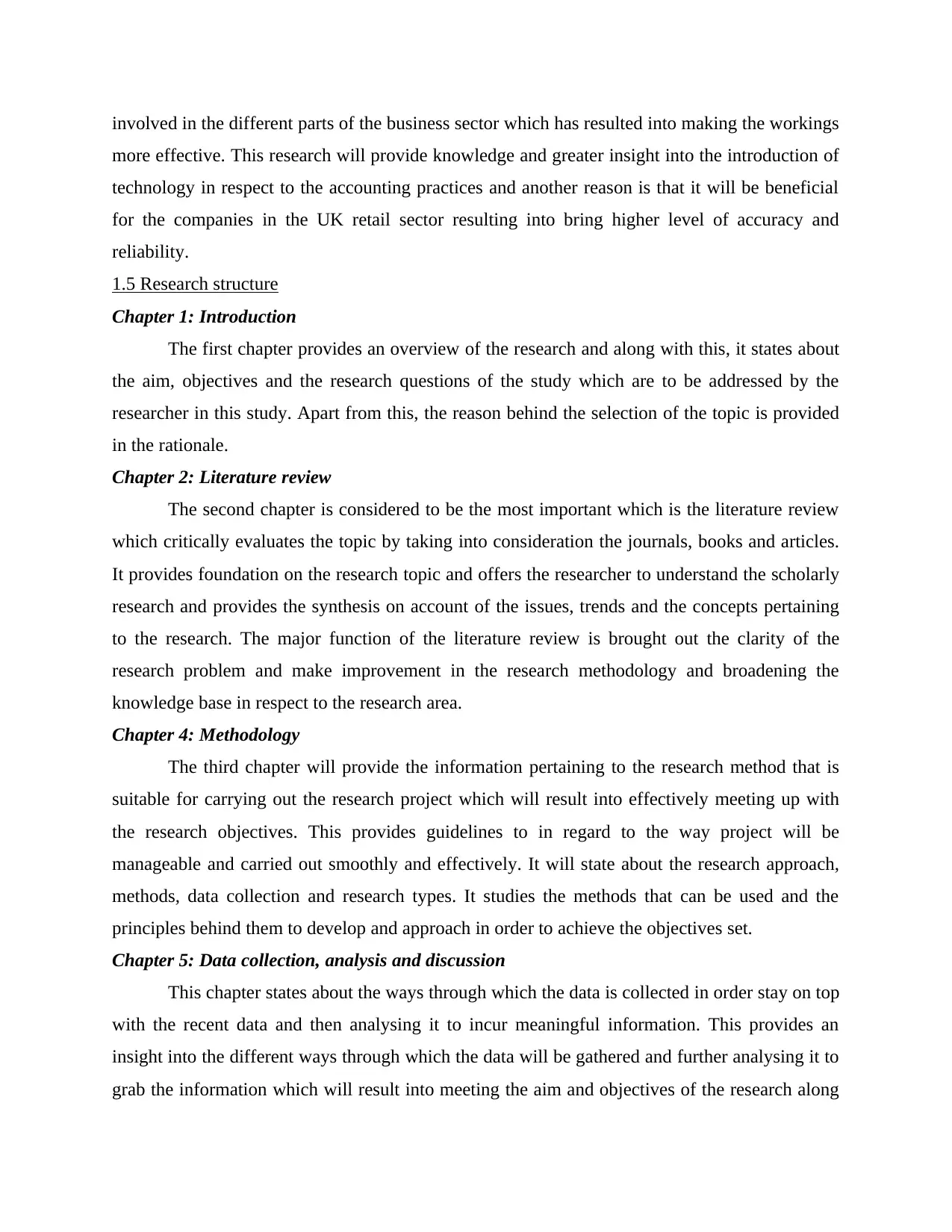
involved in the different parts of the business sector which has resulted into making the workings
more effective. This research will provide knowledge and greater insight into the introduction of
technology in respect to the accounting practices and another reason is that it will be beneficial
for the companies in the UK retail sector resulting into bring higher level of accuracy and
reliability.
1.5 Research structure
Chapter 1: Introduction
The first chapter provides an overview of the research and along with this, it states about
the aim, objectives and the research questions of the study which are to be addressed by the
researcher in this study. Apart from this, the reason behind the selection of the topic is provided
in the rationale.
Chapter 2: Literature review
The second chapter is considered to be the most important which is the literature review
which critically evaluates the topic by taking into consideration the journals, books and articles.
It provides foundation on the research topic and offers the researcher to understand the scholarly
research and provides the synthesis on account of the issues, trends and the concepts pertaining
to the research. The major function of the literature review is brought out the clarity of the
research problem and make improvement in the research methodology and broadening the
knowledge base in respect to the research area.
Chapter 4: Methodology
The third chapter will provide the information pertaining to the research method that is
suitable for carrying out the research project which will result into effectively meeting up with
the research objectives. This provides guidelines to in regard to the way project will be
manageable and carried out smoothly and effectively. It will state about the research approach,
methods, data collection and research types. It studies the methods that can be used and the
principles behind them to develop and approach in order to achieve the objectives set.
Chapter 5: Data collection, analysis and discussion
This chapter states about the ways through which the data is collected in order stay on top
with the recent data and then analysing it to incur meaningful information. This provides an
insight into the different ways through which the data will be gathered and further analysing it to
grab the information which will result into meeting the aim and objectives of the research along
more effective. This research will provide knowledge and greater insight into the introduction of
technology in respect to the accounting practices and another reason is that it will be beneficial
for the companies in the UK retail sector resulting into bring higher level of accuracy and
reliability.
1.5 Research structure
Chapter 1: Introduction
The first chapter provides an overview of the research and along with this, it states about
the aim, objectives and the research questions of the study which are to be addressed by the
researcher in this study. Apart from this, the reason behind the selection of the topic is provided
in the rationale.
Chapter 2: Literature review
The second chapter is considered to be the most important which is the literature review
which critically evaluates the topic by taking into consideration the journals, books and articles.
It provides foundation on the research topic and offers the researcher to understand the scholarly
research and provides the synthesis on account of the issues, trends and the concepts pertaining
to the research. The major function of the literature review is brought out the clarity of the
research problem and make improvement in the research methodology and broadening the
knowledge base in respect to the research area.
Chapter 4: Methodology
The third chapter will provide the information pertaining to the research method that is
suitable for carrying out the research project which will result into effectively meeting up with
the research objectives. This provides guidelines to in regard to the way project will be
manageable and carried out smoothly and effectively. It will state about the research approach,
methods, data collection and research types. It studies the methods that can be used and the
principles behind them to develop and approach in order to achieve the objectives set.
Chapter 5: Data collection, analysis and discussion
This chapter states about the ways through which the data is collected in order stay on top
with the recent data and then analysing it to incur meaningful information. This provides an
insight into the different ways through which the data will be gathered and further analysing it to
grab the information which will result into meeting the aim and objectives of the research along
Paraphrase This Document
Need a fresh take? Get an instant paraphrase of this document with our AI Paraphraser
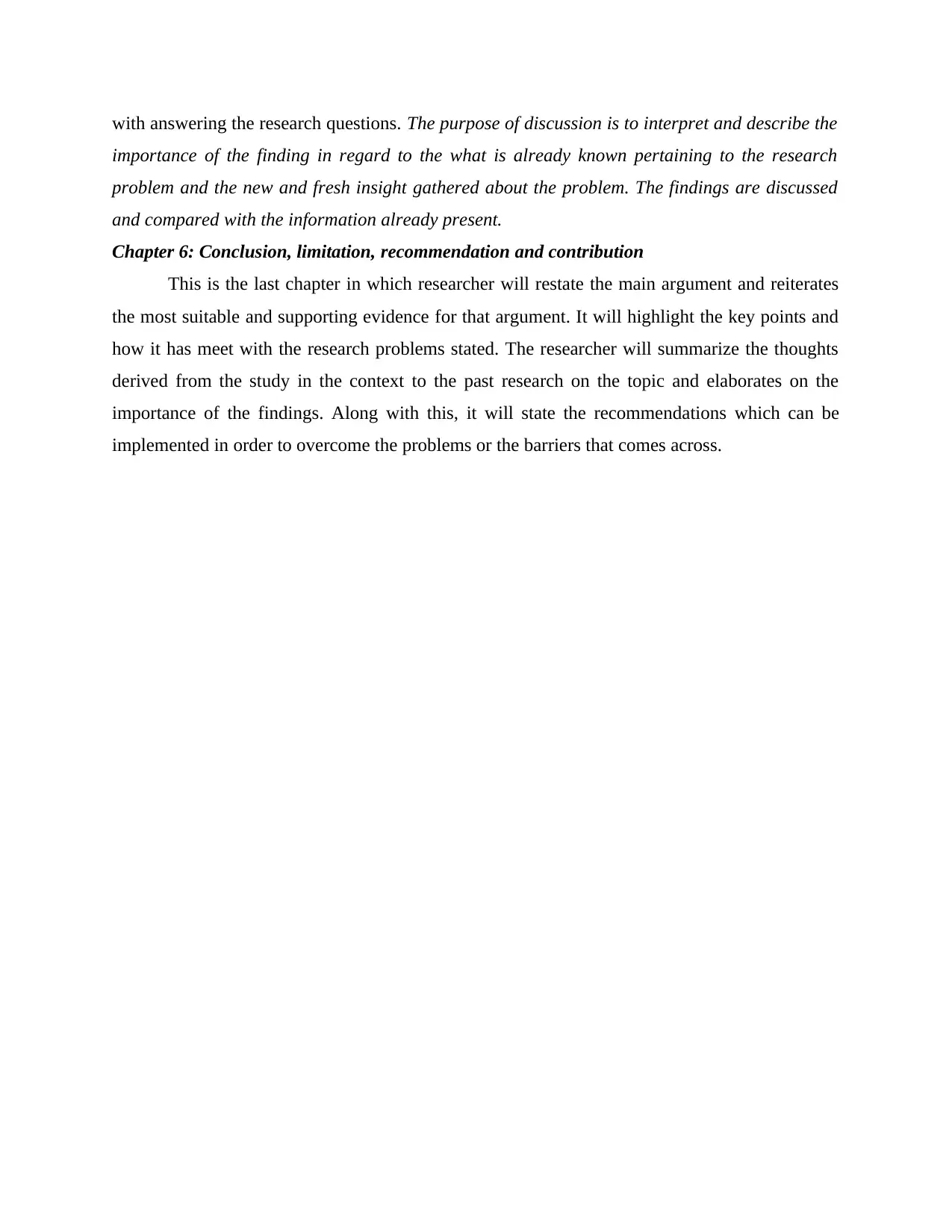
with answering the research questions. The purpose of discussion is to interpret and describe the
importance of the finding in regard to the what is already known pertaining to the research
problem and the new and fresh insight gathered about the problem. The findings are discussed
and compared with the information already present.
Chapter 6: Conclusion, limitation, recommendation and contribution
This is the last chapter in which researcher will restate the main argument and reiterates
the most suitable and supporting evidence for that argument. It will highlight the key points and
how it has meet with the research problems stated. The researcher will summarize the thoughts
derived from the study in the context to the past research on the topic and elaborates on the
importance of the findings. Along with this, it will state the recommendations which can be
implemented in order to overcome the problems or the barriers that comes across.
importance of the finding in regard to the what is already known pertaining to the research
problem and the new and fresh insight gathered about the problem. The findings are discussed
and compared with the information already present.
Chapter 6: Conclusion, limitation, recommendation and contribution
This is the last chapter in which researcher will restate the main argument and reiterates
the most suitable and supporting evidence for that argument. It will highlight the key points and
how it has meet with the research problems stated. The researcher will summarize the thoughts
derived from the study in the context to the past research on the topic and elaborates on the
importance of the findings. Along with this, it will state the recommendations which can be
implemented in order to overcome the problems or the barriers that comes across.
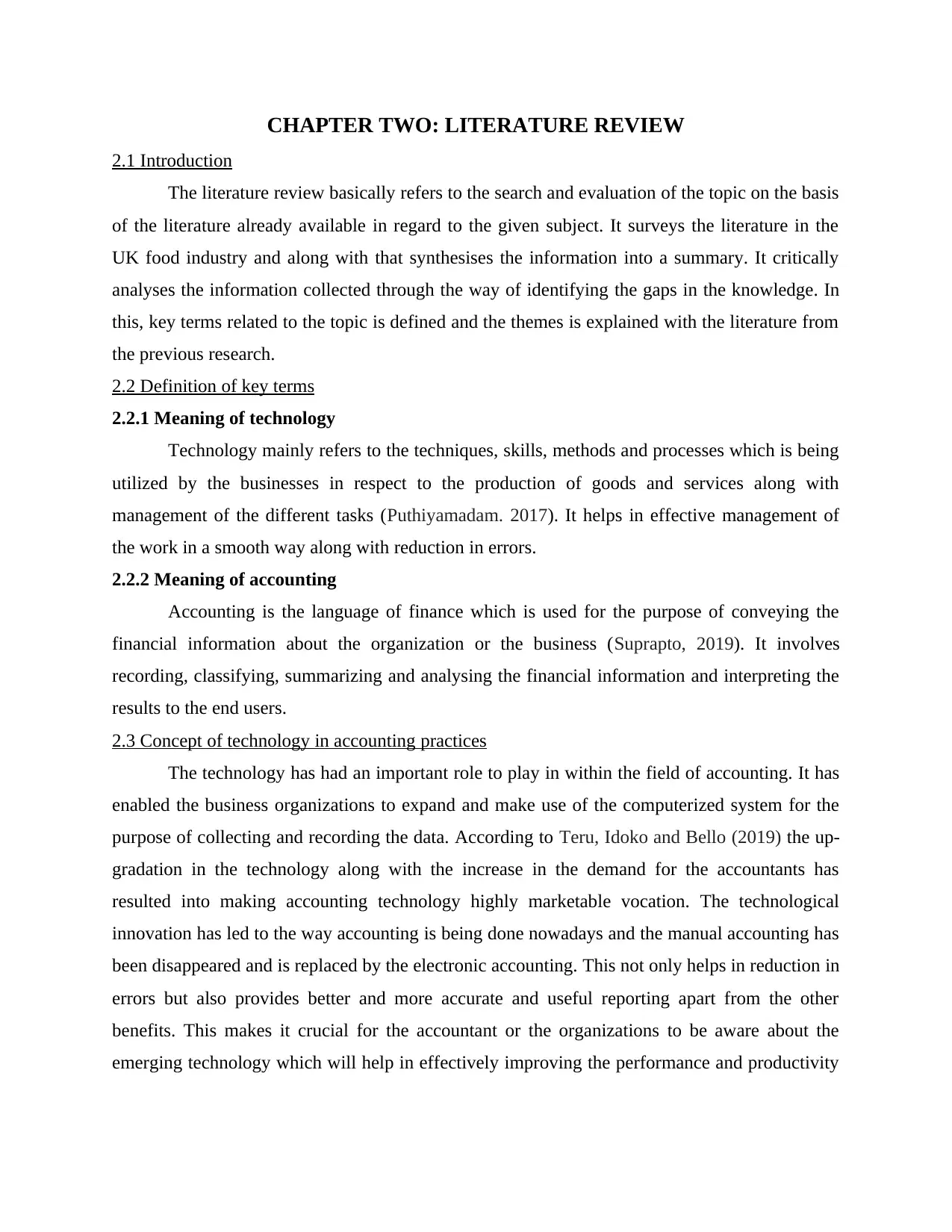
CHAPTER TWO: LITERATURE REVIEW
2.1 Introduction
The literature review basically refers to the search and evaluation of the topic on the basis
of the literature already available in regard to the given subject. It surveys the literature in the
UK food industry and along with that synthesises the information into a summary. It critically
analyses the information collected through the way of identifying the gaps in the knowledge. In
this, key terms related to the topic is defined and the themes is explained with the literature from
the previous research.
2.2 Definition of key terms
2.2.1 Meaning of technology
Technology mainly refers to the techniques, skills, methods and processes which is being
utilized by the businesses in respect to the production of goods and services along with
management of the different tasks (Puthiyamadam. 2017). It helps in effective management of
the work in a smooth way along with reduction in errors.
2.2.2 Meaning of accounting
Accounting is the language of finance which is used for the purpose of conveying the
financial information about the organization or the business (Suprapto, 2019). It involves
recording, classifying, summarizing and analysing the financial information and interpreting the
results to the end users.
2.3 Concept of technology in accounting practices
The technology has had an important role to play in within the field of accounting. It has
enabled the business organizations to expand and make use of the computerized system for the
purpose of collecting and recording the data. According to Teru, Idoko and Bello (2019) the up-
gradation in the technology along with the increase in the demand for the accountants has
resulted into making accounting technology highly marketable vocation. The technological
innovation has led to the way accounting is being done nowadays and the manual accounting has
been disappeared and is replaced by the electronic accounting. This not only helps in reduction in
errors but also provides better and more accurate and useful reporting apart from the other
benefits. This makes it crucial for the accountant or the organizations to be aware about the
emerging technology which will help in effectively improving the performance and productivity
2.1 Introduction
The literature review basically refers to the search and evaluation of the topic on the basis
of the literature already available in regard to the given subject. It surveys the literature in the
UK food industry and along with that synthesises the information into a summary. It critically
analyses the information collected through the way of identifying the gaps in the knowledge. In
this, key terms related to the topic is defined and the themes is explained with the literature from
the previous research.
2.2 Definition of key terms
2.2.1 Meaning of technology
Technology mainly refers to the techniques, skills, methods and processes which is being
utilized by the businesses in respect to the production of goods and services along with
management of the different tasks (Puthiyamadam. 2017). It helps in effective management of
the work in a smooth way along with reduction in errors.
2.2.2 Meaning of accounting
Accounting is the language of finance which is used for the purpose of conveying the
financial information about the organization or the business (Suprapto, 2019). It involves
recording, classifying, summarizing and analysing the financial information and interpreting the
results to the end users.
2.3 Concept of technology in accounting practices
The technology has had an important role to play in within the field of accounting. It has
enabled the business organizations to expand and make use of the computerized system for the
purpose of collecting and recording the data. According to Teru, Idoko and Bello (2019) the up-
gradation in the technology along with the increase in the demand for the accountants has
resulted into making accounting technology highly marketable vocation. The technological
innovation has led to the way accounting is being done nowadays and the manual accounting has
been disappeared and is replaced by the electronic accounting. This not only helps in reduction in
errors but also provides better and more accurate and useful reporting apart from the other
benefits. This makes it crucial for the accountant or the organizations to be aware about the
emerging technology which will help in effectively improving the performance and productivity
⊘ This is a preview!⊘
Do you want full access?
Subscribe today to unlock all pages.

Trusted by 1+ million students worldwide
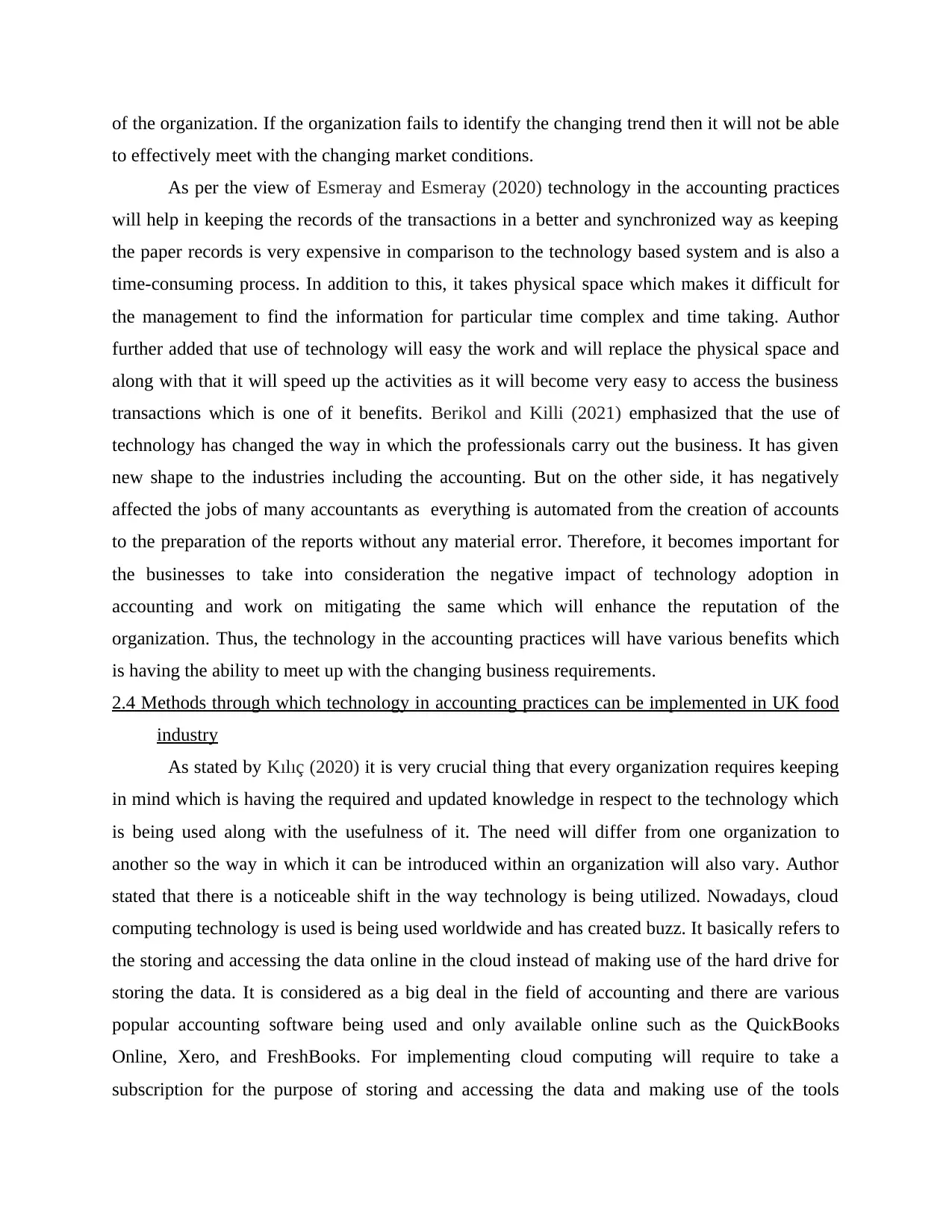
of the organization. If the organization fails to identify the changing trend then it will not be able
to effectively meet with the changing market conditions.
As per the view of Esmeray and Esmeray (2020) technology in the accounting practices
will help in keeping the records of the transactions in a better and synchronized way as keeping
the paper records is very expensive in comparison to the technology based system and is also a
time-consuming process. In addition to this, it takes physical space which makes it difficult for
the management to find the information for particular time complex and time taking. Author
further added that use of technology will easy the work and will replace the physical space and
along with that it will speed up the activities as it will become very easy to access the business
transactions which is one of it benefits. Berikol and Killi (2021) emphasized that the use of
technology has changed the way in which the professionals carry out the business. It has given
new shape to the industries including the accounting. But on the other side, it has negatively
affected the jobs of many accountants as everything is automated from the creation of accounts
to the preparation of the reports without any material error. Therefore, it becomes important for
the businesses to take into consideration the negative impact of technology adoption in
accounting and work on mitigating the same which will enhance the reputation of the
organization. Thus, the technology in the accounting practices will have various benefits which
is having the ability to meet up with the changing business requirements.
2.4 Methods through which technology in accounting practices can be implemented in UK food
industry
As stated by Kılıç (2020) it is very crucial thing that every organization requires keeping
in mind which is having the required and updated knowledge in respect to the technology which
is being used along with the usefulness of it. The need will differ from one organization to
another so the way in which it can be introduced within an organization will also vary. Author
stated that there is a noticeable shift in the way technology is being utilized. Nowadays, cloud
computing technology is used is being used worldwide and has created buzz. It basically refers to
the storing and accessing the data online in the cloud instead of making use of the hard drive for
storing the data. It is considered as a big deal in the field of accounting and there are various
popular accounting software being used and only available online such as the QuickBooks
Online, Xero, and FreshBooks. For implementing cloud computing will require to take a
subscription for the purpose of storing and accessing the data and making use of the tools
to effectively meet with the changing market conditions.
As per the view of Esmeray and Esmeray (2020) technology in the accounting practices
will help in keeping the records of the transactions in a better and synchronized way as keeping
the paper records is very expensive in comparison to the technology based system and is also a
time-consuming process. In addition to this, it takes physical space which makes it difficult for
the management to find the information for particular time complex and time taking. Author
further added that use of technology will easy the work and will replace the physical space and
along with that it will speed up the activities as it will become very easy to access the business
transactions which is one of it benefits. Berikol and Killi (2021) emphasized that the use of
technology has changed the way in which the professionals carry out the business. It has given
new shape to the industries including the accounting. But on the other side, it has negatively
affected the jobs of many accountants as everything is automated from the creation of accounts
to the preparation of the reports without any material error. Therefore, it becomes important for
the businesses to take into consideration the negative impact of technology adoption in
accounting and work on mitigating the same which will enhance the reputation of the
organization. Thus, the technology in the accounting practices will have various benefits which
is having the ability to meet up with the changing business requirements.
2.4 Methods through which technology in accounting practices can be implemented in UK food
industry
As stated by Kılıç (2020) it is very crucial thing that every organization requires keeping
in mind which is having the required and updated knowledge in respect to the technology which
is being used along with the usefulness of it. The need will differ from one organization to
another so the way in which it can be introduced within an organization will also vary. Author
stated that there is a noticeable shift in the way technology is being utilized. Nowadays, cloud
computing technology is used is being used worldwide and has created buzz. It basically refers to
the storing and accessing the data online in the cloud instead of making use of the hard drive for
storing the data. It is considered as a big deal in the field of accounting and there are various
popular accounting software being used and only available online such as the QuickBooks
Online, Xero, and FreshBooks. For implementing cloud computing will require to take a
subscription for the purpose of storing and accessing the data and making use of the tools
Paraphrase This Document
Need a fresh take? Get an instant paraphrase of this document with our AI Paraphraser
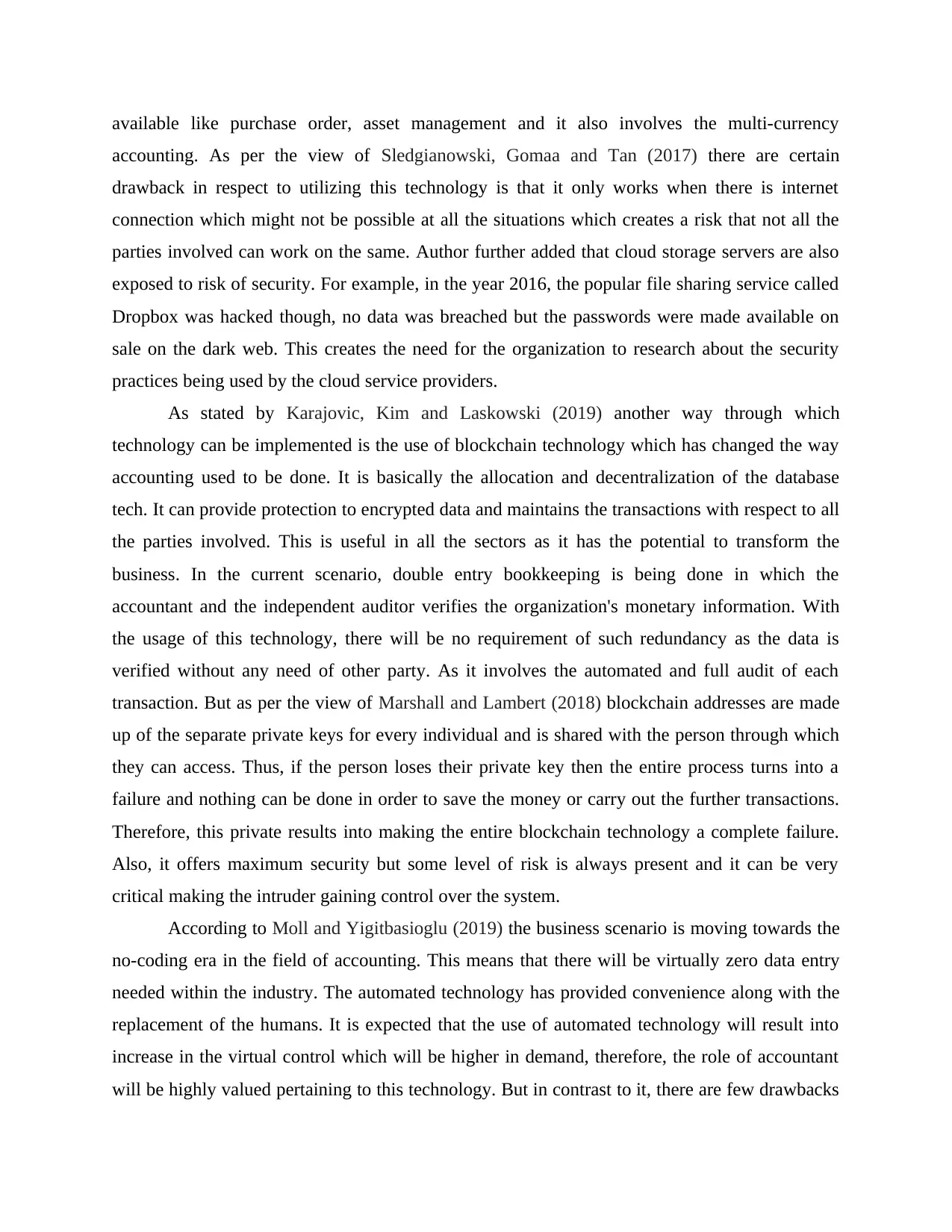
available like purchase order, asset management and it also involves the multi-currency
accounting. As per the view of Sledgianowski, Gomaa and Tan (2017) there are certain
drawback in respect to utilizing this technology is that it only works when there is internet
connection which might not be possible at all the situations which creates a risk that not all the
parties involved can work on the same. Author further added that cloud storage servers are also
exposed to risk of security. For example, in the year 2016, the popular file sharing service called
Dropbox was hacked though, no data was breached but the passwords were made available on
sale on the dark web. This creates the need for the organization to research about the security
practices being used by the cloud service providers.
As stated by Karajovic, Kim and Laskowski (2019) another way through which
technology can be implemented is the use of blockchain technology which has changed the way
accounting used to be done. It is basically the allocation and decentralization of the database
tech. It can provide protection to encrypted data and maintains the transactions with respect to all
the parties involved. This is useful in all the sectors as it has the potential to transform the
business. In the current scenario, double entry bookkeeping is being done in which the
accountant and the independent auditor verifies the organization's monetary information. With
the usage of this technology, there will be no requirement of such redundancy as the data is
verified without any need of other party. As it involves the automated and full audit of each
transaction. But as per the view of Marshall and Lambert (2018) blockchain addresses are made
up of the separate private keys for every individual and is shared with the person through which
they can access. Thus, if the person loses their private key then the entire process turns into a
failure and nothing can be done in order to save the money or carry out the further transactions.
Therefore, this private results into making the entire blockchain technology a complete failure.
Also, it offers maximum security but some level of risk is always present and it can be very
critical making the intruder gaining control over the system.
According to Moll and Yigitbasioglu (2019) the business scenario is moving towards the
no-coding era in the field of accounting. This means that there will be virtually zero data entry
needed within the industry. The automated technology has provided convenience along with the
replacement of the humans. It is expected that the use of automated technology will result into
increase in the virtual control which will be higher in demand, therefore, the role of accountant
will be highly valued pertaining to this technology. But in contrast to it, there are few drawbacks
accounting. As per the view of Sledgianowski, Gomaa and Tan (2017) there are certain
drawback in respect to utilizing this technology is that it only works when there is internet
connection which might not be possible at all the situations which creates a risk that not all the
parties involved can work on the same. Author further added that cloud storage servers are also
exposed to risk of security. For example, in the year 2016, the popular file sharing service called
Dropbox was hacked though, no data was breached but the passwords were made available on
sale on the dark web. This creates the need for the organization to research about the security
practices being used by the cloud service providers.
As stated by Karajovic, Kim and Laskowski (2019) another way through which
technology can be implemented is the use of blockchain technology which has changed the way
accounting used to be done. It is basically the allocation and decentralization of the database
tech. It can provide protection to encrypted data and maintains the transactions with respect to all
the parties involved. This is useful in all the sectors as it has the potential to transform the
business. In the current scenario, double entry bookkeeping is being done in which the
accountant and the independent auditor verifies the organization's monetary information. With
the usage of this technology, there will be no requirement of such redundancy as the data is
verified without any need of other party. As it involves the automated and full audit of each
transaction. But as per the view of Marshall and Lambert (2018) blockchain addresses are made
up of the separate private keys for every individual and is shared with the person through which
they can access. Thus, if the person loses their private key then the entire process turns into a
failure and nothing can be done in order to save the money or carry out the further transactions.
Therefore, this private results into making the entire blockchain technology a complete failure.
Also, it offers maximum security but some level of risk is always present and it can be very
critical making the intruder gaining control over the system.
According to Moll and Yigitbasioglu (2019) the business scenario is moving towards the
no-coding era in the field of accounting. This means that there will be virtually zero data entry
needed within the industry. The automated technology has provided convenience along with the
replacement of the humans. It is expected that the use of automated technology will result into
increase in the virtual control which will be higher in demand, therefore, the role of accountant
will be highly valued pertaining to this technology. But in contrast to it, there are few drawbacks
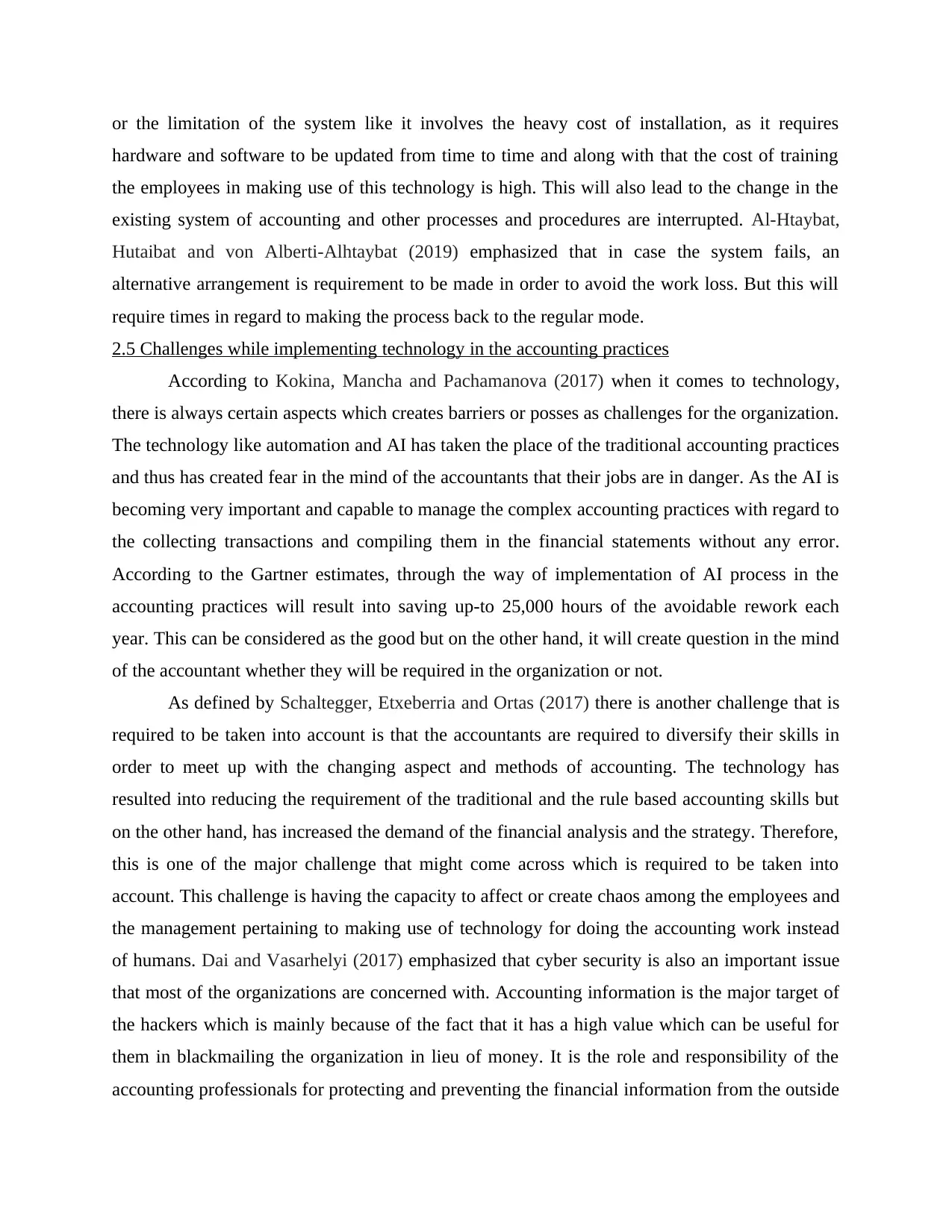
or the limitation of the system like it involves the heavy cost of installation, as it requires
hardware and software to be updated from time to time and along with that the cost of training
the employees in making use of this technology is high. This will also lead to the change in the
existing system of accounting and other processes and procedures are interrupted. Al-Htaybat,
Hutaibat and von Alberti-Alhtaybat (2019) emphasized that in case the system fails, an
alternative arrangement is requirement to be made in order to avoid the work loss. But this will
require times in regard to making the process back to the regular mode.
2.5 Challenges while implementing technology in the accounting practices
According to Kokina, Mancha and Pachamanova (2017) when it comes to technology,
there is always certain aspects which creates barriers or posses as challenges for the organization.
The technology like automation and AI has taken the place of the traditional accounting practices
and thus has created fear in the mind of the accountants that their jobs are in danger. As the AI is
becoming very important and capable to manage the complex accounting practices with regard to
the collecting transactions and compiling them in the financial statements without any error.
According to the Gartner estimates, through the way of implementation of AI process in the
accounting practices will result into saving up-to 25,000 hours of the avoidable rework each
year. This can be considered as the good but on the other hand, it will create question in the mind
of the accountant whether they will be required in the organization or not.
As defined by Schaltegger, Etxeberria and Ortas (2017) there is another challenge that is
required to be taken into account is that the accountants are required to diversify their skills in
order to meet up with the changing aspect and methods of accounting. The technology has
resulted into reducing the requirement of the traditional and the rule based accounting skills but
on the other hand, has increased the demand of the financial analysis and the strategy. Therefore,
this is one of the major challenge that might come across which is required to be taken into
account. This challenge is having the capacity to affect or create chaos among the employees and
the management pertaining to making use of technology for doing the accounting work instead
of humans. Dai and Vasarhelyi (2017) emphasized that cyber security is also an important issue
that most of the organizations are concerned with. Accounting information is the major target of
the hackers which is mainly because of the fact that it has a high value which can be useful for
them in blackmailing the organization in lieu of money. It is the role and responsibility of the
accounting professionals for protecting and preventing the financial information from the outside
hardware and software to be updated from time to time and along with that the cost of training
the employees in making use of this technology is high. This will also lead to the change in the
existing system of accounting and other processes and procedures are interrupted. Al-Htaybat,
Hutaibat and von Alberti-Alhtaybat (2019) emphasized that in case the system fails, an
alternative arrangement is requirement to be made in order to avoid the work loss. But this will
require times in regard to making the process back to the regular mode.
2.5 Challenges while implementing technology in the accounting practices
According to Kokina, Mancha and Pachamanova (2017) when it comes to technology,
there is always certain aspects which creates barriers or posses as challenges for the organization.
The technology like automation and AI has taken the place of the traditional accounting practices
and thus has created fear in the mind of the accountants that their jobs are in danger. As the AI is
becoming very important and capable to manage the complex accounting practices with regard to
the collecting transactions and compiling them in the financial statements without any error.
According to the Gartner estimates, through the way of implementation of AI process in the
accounting practices will result into saving up-to 25,000 hours of the avoidable rework each
year. This can be considered as the good but on the other hand, it will create question in the mind
of the accountant whether they will be required in the organization or not.
As defined by Schaltegger, Etxeberria and Ortas (2017) there is another challenge that is
required to be taken into account is that the accountants are required to diversify their skills in
order to meet up with the changing aspect and methods of accounting. The technology has
resulted into reducing the requirement of the traditional and the rule based accounting skills but
on the other hand, has increased the demand of the financial analysis and the strategy. Therefore,
this is one of the major challenge that might come across which is required to be taken into
account. This challenge is having the capacity to affect or create chaos among the employees and
the management pertaining to making use of technology for doing the accounting work instead
of humans. Dai and Vasarhelyi (2017) emphasized that cyber security is also an important issue
that most of the organizations are concerned with. Accounting information is the major target of
the hackers which is mainly because of the fact that it has a high value which can be useful for
them in blackmailing the organization in lieu of money. It is the role and responsibility of the
accounting professionals for protecting and preventing the financial information from the outside
⊘ This is a preview!⊘
Do you want full access?
Subscribe today to unlock all pages.

Trusted by 1+ million students worldwide
1 out of 30
Related Documents
Your All-in-One AI-Powered Toolkit for Academic Success.
+13062052269
info@desklib.com
Available 24*7 on WhatsApp / Email
![[object Object]](/_next/static/media/star-bottom.7253800d.svg)
Unlock your academic potential
Copyright © 2020–2025 A2Z Services. All Rights Reserved. Developed and managed by ZUCOL.





